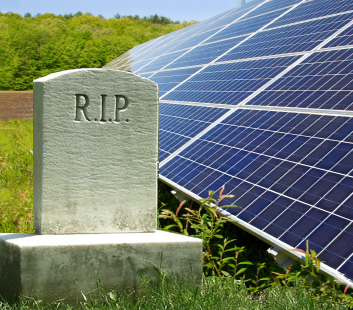 One of the big pieces of a future that makes sense is an energy system that involves clean power, less waste, more intelligence, and a wider distribution of economic benefits. (Think locally owned solar panels hooked into a smart grid.) I lump all that under the term “distributed energy” and have been making fitful efforts to track some of the battles going on around it.
One of the big pieces of a future that makes sense is an energy system that involves clean power, less waste, more intelligence, and a wider distribution of economic benefits. (Think locally owned solar panels hooked into a smart grid.) I lump all that under the term “distributed energy” and have been making fitful efforts to track some of the battles going on around it.
The latest episode is a sad one. Last year in California, state Sen. Lois Wolk (D) set out to tackle a pretty simple problem: Access to distributed energy (mostly rooftop solar panels) is restricted to those who can afford it and own a suitable roof. About 75 percent of Californians don’t fall into that category — they either rent, don’t have the equity, or have a shaded or wrong-facing roof. That’s a huge market to be tapped.
So she put forward Senate Bill 843, which would allow customers in the service territories of the state’s three big investor-owned utilities — Pacific Gas & Electric (PG&E), Southern California Edison (SCE), and San Diego Gas & Electric (SDG&E) — to “subscribe” to distributed energy projects (20 megawatts or less) anywhere in their territories. So, for instance, a condo co-op could get together and invest in a solar project covering a nearby parking garage. Or a congregation could get together and invest in panels for the top of their church. They would sign a contract with a solar developer and pay a monthly fee (wrapped into their power bill) for a portion of the energy produced. Under the legislation, up to 2 gigawatts of power could be financed this way across the state; no state money would be required.
According to a report by Vote Solar [PDF], in the process of adding 2 GW of distributed renewable energy, the program would create 12,000 new jobs, $230 million in state sales tax revenue, and $7.5 billion of economic activity in the state. The bill was backed by a broad coalition that included businesses, schools, nonprofit groups, and the Department of Defense.
Sounds good, right? But it didn’t sound good to the big quasi-monopoly utilities, PG&E and SCE (SDG&E supported the bill). Late last week, they led a last-minute flurry of lobbying and killed it.
The murder took place in the Assembly Committee on Utilities and Commerce, under what sounds like some pretty shady circumstances. Apparently Wolk made a deal with committee chair to back a scaled-down version of the program, but once committee doors shut, the chair flip-flopped. Wolk was blunt: “PG&E and Southern California Edison control the committee … the coalition of support behind this measure was simply no match for the high paid lobbyists and the campaign contributions of these monopoly corporations.”
One of the utilities’ objections (which are detailed in this op-ed from PG&E) was that the bill would shift the cost of maintaining the electricity system to other customers. This is, um, bullsh*t. SB 843 was explicitly designed so that participating customers would still pay all their own transmission, distribution, and public-purpose charges. And regardless, one of the great benefits of distributed energy is that it reduces those costs; you don’t need new power lines when the power plant is on your roof.
The utilities’ alleged concern over costs is touching, but somewhat ironic. PG&E is still paying out a $70 million settlement over its boneheaded San Bruno pipeline explosion. Guess where that money comes from? That’s right, ratepayers. Oh, and PG&E also recently tried to bump up its guaranteed “return on equity” from 8.75 percent to 11 percent, which the Division of Ratepayer Advocates deemed “out of line with today’s market and unfair to customers.” Guess where that extra annual $337 million in profits would have come from? Right again. As for SCE, its shareholders are currently banking $54 million a month in profits for running the San Onofre nuclear plant, which, um, isn’t running. Guess where that money is coming from? Yup.
So really, utility concern over ratepayer costs? Spare me.
I suspect the real objections were elsewhere. First, the 2 GW in distributed solar wouldn’t have counted toward the utilities’ obligations under California’s aggressive renewable energy mandate, under which utilities have to get 33 percent of their energy from renewables by 2020.
Second and relatedly, the program would effectively have cut utilities out as middlemen. Customers would have been contracting directly with power providers. That is a threat to the entire utility model, which relies on tidy planning, captive ratepayers, and a publicly guaranteed rate of return. That model all but prohibits the kind of disruptive evolution the electricity system desperately needs, but it works quite well for utility shareholders and they will fight to the death to preserve it.
I don’t know how the program would have played out had the bill passed. Maybe it really would have been a mishegas like the utilities warned. But these facts remain:
- We need rapid evolution in the electricity sector.
- Under the current regulatory regime, utilities are all but incapable of that kind of innovation.
- The prospects of reforming that regulatory regime are dim.
Given all that, I don’t see any alternative but to go around utilities, to find ways for customers — communities, businesses, civic groups — to work directly with microgrid and distributed energy providers. We need some of that magic that comes from a competitive market and we’ll never get it as long as utilities maintain their monopoly on power.
On that note: supporters of SB843 intend to redraft it and have another go at it in January. I’ll keep you posted.




